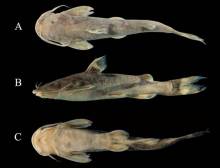
Alias Bagarius bagarius,Yellow croaker, yellow croaker
Family Siluriformes Siluridae Genus
Life No verification information
The Latin name of the fish is Bagarius bagarius, which is one of the species of the genus Bagarius in the family Siluridae of the order Siluriformes of the class Actinopterygii. It is commonly known as the melon fish.

The fish is a carnivorous fish, fierce and predatory. It feeds on mollusks and small fish by smell. It also feeds on carrion and frogs and shrimps. It breeds in May and June. The number of its wild state is not well known. But it is often seen. In recent decades, due to the rapid increase in population in the production area, the use of harmful fishing methods such as electrocution, poisoning, and blasting has become more common, resulting in a sharp decrease in its resources and shrinking in size year by year. Most of the juveniles can reproduce.
Listed in the second level of China's "National Key Protected Wildlife List".
Protect wild animals and eliminate game.
Maintaining ecological balance is everyone's responsibility!